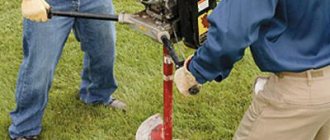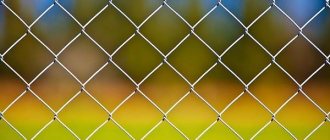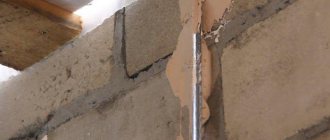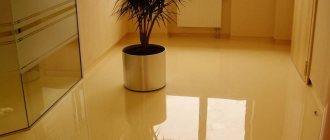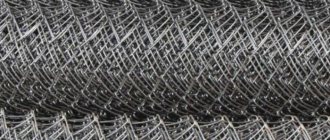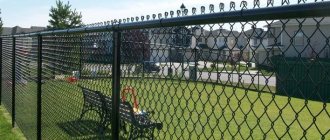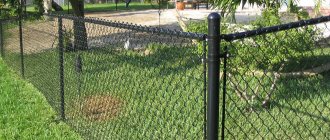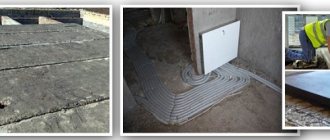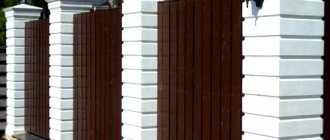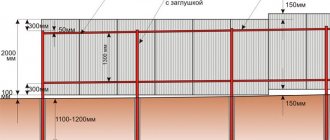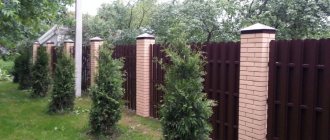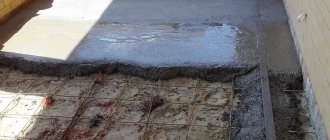The fence between adjacent areas should not cast a shadow or interfere with natural ventilation. Both parties are interested in meeting these regulatory requirements, especially since such fences can be installed on a shared basis. There are several options, but the easiest to implement and affordable in our store is a chain-link fence.
The fence between adjacent areas should not cast a shadow or interfere with natural ventilation. Both parties are interested in meeting these regulatory requirements, especially since such fences can be installed on a shared basis. There are several options, but the easiest to implement and affordable in our store is a chain-link fence.
Types of mesh
Three main types of products are produced from the following materials:
Uncoated steel mesh
Uncoated steel mesh - during production it is not subjected to heat treatment and is not protected with a layer of zinc.
A huge disadvantage of this material is its susceptibility to harmful environmental influences. Such a network is especially afraid of damp sea air. To avoid the chain-link mesh becoming unusable soon, you will have to paint it yourself.
There are options for its use that do not require painting - for example, as a reinforcing mesh for a foundation or when plastering walls. It makes sense to use it as a fence only if there is not enough money for anything else.
Galvanized steel mesh
Galvanized steel mesh - this option is much more serious in terms of both durability and aesthetics. Produced from wire with a diameter of up to 5 mm. The material, thanks to special temperature treatment during manufacturing, is resistant to temperature changes and is not afraid of either frost or heat.
Atmospheric precipitation also does not affect galvanization. The cells are made up to 10 cm in size, and the roll width reaches 2 m. The service life of the material, depending on climatic conditions, is 15-20 years.
Polymer-coated steel mesh
PVC-coated chain-link mesh is produced in two types - with and without pre-galvanization. If you have the opportunity to purchase one that has been galvanized and then treated with PVC, you need to take it.
It is very durable, and in terms of corrosion resistance and strength, with other indicators being equal - wire thickness, cell size - it is superior to all others, although it is more expensive.
Painting a chain-link fence
The installation has been completed and the last stage of construction is painting the pillars , crossbars and frames. This process cannot be delayed , since even a little rain will occur and the unprotected metal surface will quickly begin to rust . There are specialized metal paints for external surfaces; choosing it is a topic for another conversation.
Chain-link is an excellent mesh for fencing, but there is still one drawback . Since this is a woven mesh, if one wire is damaged , the fabric diverges (unravels).
We introduced you in general terms to the types, characteristics and even disadvantages of mesh fencing , we looked at the simplest options for how to install a chain-link fence - now you have an idea of the issue and understand whether such a solution is suitable for you, whether you can cope with the installation of a mesh Or is it better to trust the professionals ?
And if this is not your option, then consider another mesh fence for yourself - a welded fence made of 3D panels, which, of course, is more expensive than that made of chain-link, but has undoubted advantages over the latter: it is more reliable, lasts much longer and is easy to install - like a construction set!
Where to buy chain link for a fence?
purchase mesh, posts, wire and fasteners for installing any of these mesh fences for cash or by bank transfer in Cherepovets at the Hardware Shop . View on the map. Or write to the manager and he will contact you for consultation, placing an order or purchasing.
And yes, we have craftsmen who will supply you with a turnkey fence!
REQUEST PRICES
Payment
We work under a contract with strict adherence to delivery deadlines. For non-cash and cash payments .
Criteria for choosing a mesh
The strength of a chain-link mesh depends both on the thickness of the wire used in its manufacture and on the size of the cells. The larger the cell and the thinner the wire, the flimsier the structure. Its price will, of course, be lower, but the savings are hardly appropriate in this case.
The standard sizes of chain-link mesh cells are 12.5, 25, 50 and 100 mm. The thickness of the wire is 1 mm or more.
When choosing a mesh, take into account that the declared thickness is not the net size for galvanized and PVC-coated chain-link mesh; at least 0.5 mm should be subtracted from the specified thickness.
The cost of the product directly depends on its density. A chain-link mesh made of thick wire and with a fine mesh is more dense.
A denser material will provide a more intense shadow and more restrict visibility and air circulation, which is not always a good thing. In dacha conditions, shade and poor air circulation prevent normal plant growth.
Installation technique
The fence can be installed on posts made of metal or plastic. They should be dug into the ground to a depth of 1/3 of the height. The design is light and freely ventilated, so it does not require pouring a foundation.
The mesh should be secured to the installed supports, preventing it from being pulled. Depending on the width and height of the posts, fastening will be required in two to four places. It is convenient to use nylon clamps as fasteners. And between the pillars you can fasten a strip or stretch a wire along the upper edge between the cells. Thanks to this, the grille will not sag.
You can use garden pruners or tin snips to cut the mesh fabric. Decorative fencing will last for many years and will delight you with its neat appearance.
Advantages and disadvantages of chain-link mesh
The advantages of chain-link mesh when fencing areas are:
- long service life provided that double protection is used - PVC and galvanization;
- simplicity and speed of construction;
- Possibility of use as a hedge;
- wide temperature range under which it can be operated;
- relatively affordable cost of the material;
- immunity to ultraviolet radiation;
- small mass of material;
- the ability to reuse the mesh after dismantling.
The fact that the mesh allows the sun's rays to pass through and does not impede the flow of air cannot be called an advantage or disadvantage - it all depends on what functions the fence should perform.
Welding of metal structuresFeatures of cold rolled sheets - production technology, features, dimensions, properties and markings
Technical features of hot-rolled sheet - classification, manufacturing method, application options and processing features
A disadvantage is also the low reliability of the structure compared to a stone fence - a person with metal scissors can easily pass through such a fence.
From an aesthetic point of view, chain-link mesh also does not belong to the masterpieces of architectural art. An obvious disadvantage is the susceptibility to corrosion and fragility of chain-link mesh fencing made from steel not treated with zinc or PVC.
Installation of a chain-link fence - tension.
Preparation of supports
Weld three metal hooks to each vertical support - at the top, bottom and in the middle. Long nails or pieces of steel wire, cut into pieces 6-8 centimeters long, are suitable as hooks.
Installation of chain-link mesh
Roll out the mesh fabric and begin attaching it to the posts, bending the hooks welded to them. To ease tension and eliminate sagging in the future, you can stretch a wire between the posts and roll out the roll in a vertical position, hanging the mesh on it. To make the mesh fastening more reliable, a steel rod is passed vertically through the mesh (from top to bottom), which is then welded to the vertical supports.
Continuity of the mesh is achieved by joining the panels. The chain-link rolls are connected to each other very simply.
To do this, unscrew one vertical wire from the mesh and screw it in, sequentially joining the edges of each roll. This video demonstrates this very clearly.
